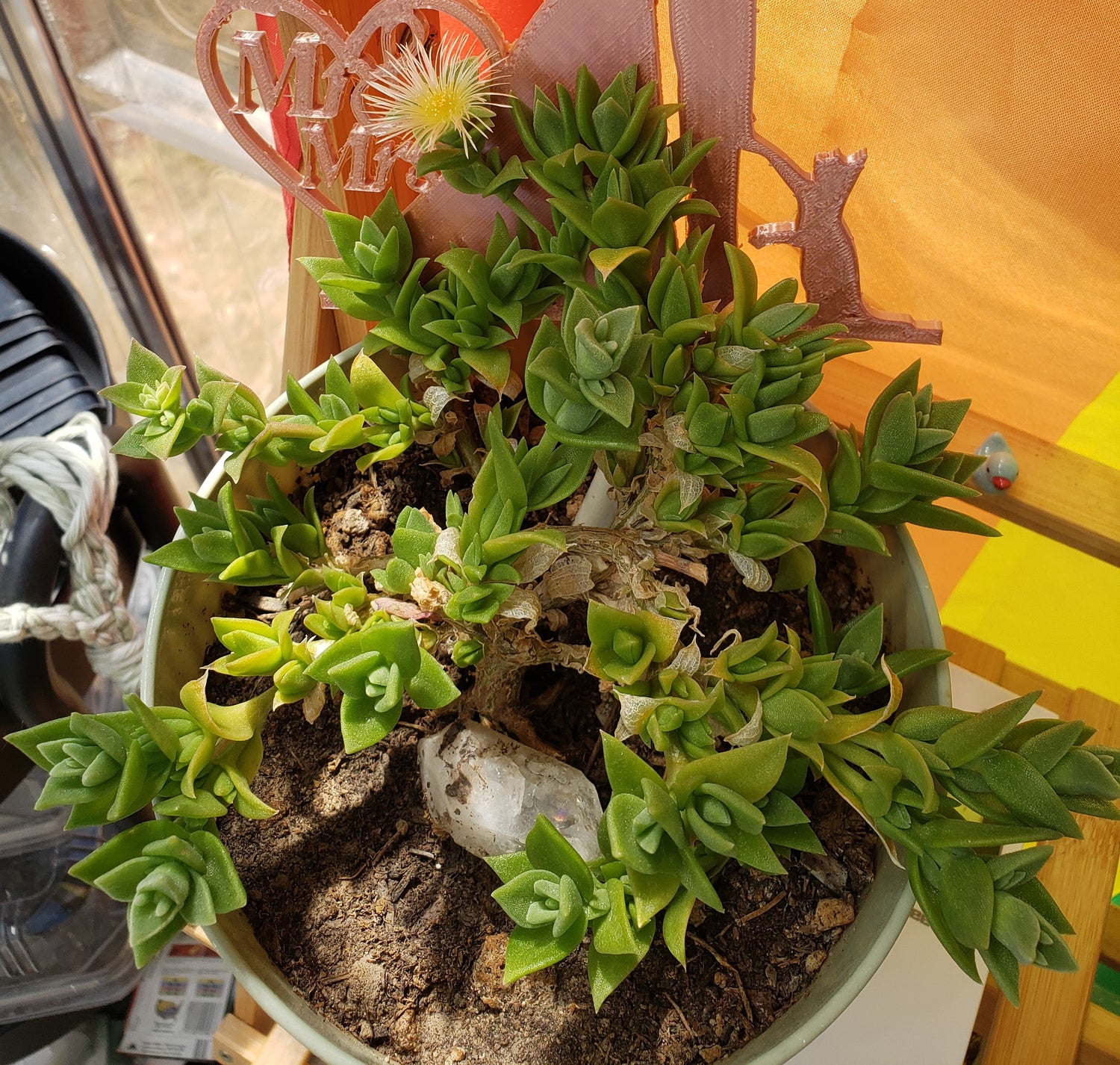About Kanna

Kanna (S. tortuosum)
Kanna is a type of succulent called an ice plant. Its leaves have a unique soft, cat tongue-like texture on the outside called idioblasts. Inside the leaf is an ion-rich water containing mesembrine. In optimal conditions they begin to grow delicate white flowers with a pollen packed center.
Kanna's native region is South Africa's Karoo Basin and Cape Provinces. While first used by South African natives, like the Khoisan, this succulent has been cultivated for hundreds of years. This plant is on a slow decline in its native region however, local South African farms help sustain the population.

Khoi & San Tribes History
The Khoi and San tribes are known to be the oldest in southern Africa, with evidence of the San 20,000 years ago. The San's nomadic lifestyle spanned from the Cape Provinces to the Drakensberg Mountains. Thriving in their expansive territory, they were evidenced by numerous rock art sites along the way.
The Khoi tribe arrived later during Nguni migration (from central Africa) around 10,000 years ago, and were semi-nomadic. Evidence shows the Khoi were pastoralists; keeping cattle, goats, & sheep displayed through rock art. The Nguni migration also made way for tribes such as the Zulu and Xhosa.
In the mid-1600's, European settlers arrived. At this point the San tribe's identity was severely weakened with evidence of combined culture, genetics, & more with Khoi tribes.
Now the Khoi and San tribes are often referred to as the Khoisan. Across South Africa, there are an estimated 100,000 Khoisan living today with as many as 35 different languages spoken.
FAQs
What are the effects of kanna?
Kanna is know to have a variety of effects depending on the concentration of specific alkaloids present. However, it is noted in research to include energetic, relaxing, and creative effects on the mind. More info here.
Like how coffee contains caffeine, the primary active compound reported in kanna is mesembrine (as well as mesembrenone, Δ7mesembrenone, and others). These compounds are reported to target the central nervous system, similar to serotonin-reuptake inhibitors, and show promise as pain/anti-inflammatory (PDE4) agents. View kanna publications here.
Is kanna addictive?
Current research indicates that kanna and its alkaloids are not addictive, but may be habit forming.
How effective are your products?
Our products may produce varying results dependent on the person, their experience with kanna, and medications. We strive to formulate our supplemental products to provide the best results in a majority of people through consistent and precise manufacturing.
(Please consult your doctor before using kanna, These products have not been reviewed by the FDA and not intended to treat any ailment or disease, 18 years and older.)
Are your products 3rd party tested?
Yes! We strive to follow GMP practices and test each batch 3rd party to ensure minimal contaminants such as bacteria, heavy metals, and alkaloid potency.
Are your products organic?
Yes! We don't use pesticides or artificial hormones to grow/cultivate our products.
Are your products sustainable?
We aim to follow South Africa’s Bioprospecting Access and Benefit Sharing (BABS) & Good Manufacturing Process (GMP) regulations.
Portion of proceeds will be donated to both the Khoisan communities and Karoo National Park to help support wildlife management and sustainability.
What's your return policy?
We are happy to accept returns within 30 days of the original purchase as long as the product is unopened and unused.
We request you send us an email via our Contact Us page and we will get back to you regarding where and how to send it.
Current Kanna Research
-

A Chewable Cure "Kanna": Biological and Pharmaceutical Properties of Sceletium tortuosum
Article Here04/28/2021 by Madira Coutlyne Manganyi et al.
This paper aims to provide an comprehensive look at historical uses of kanna, research conducted, effects of alkaloids, and general information regarding consumption.
"Historically, the plant was used by native San hunter-gatherers and Khoi people to quench their thirst, fight fatigue and for healing, social, and spiritual purposes" (Manganyi, et. al, 2021). Current research and product development efforts are conducted due to "its treatment in clinical anxiety and depression, psychological disorders, improving mood, promoting relaxation and happiness" (Manganyi, et. al, 2021).
The authors noted that "this chewable plant has been prepared in various forms such as capsules, gel caps, resin, teas, and tinctures" in recent endeavors to explore the plants effectiveness (Manganyi, et. al, 2021). Furthermore, the paper ends with the conclusion that "affordability, availability, and indigenous knowledge of medicinal plants make them an ideal alternative to the overpriced, toxic conventional medications on the market" (Manganyi, et. al, 2021).
-

Examining the Key Psychoactive Alkaloids Responsible for Kanna Effects
Article Here02/13/2024 by Elena Schmidt
While the plant contains up to nine alkaloids, there are four main alkaloids that aid in common effects. These compounds include mesembrine (key compound), mesembrenol, mesembrenone, & mesembranol.
The combination of these alkaloids primarily inhibit the PDE4B enzyme. This enzyme "plays a role in managing mood and mental functions" (Schmidt, 2024). Additionally, mesembrine & mesembranol "help manage mood and anxiety through action as a serotonin reuptake inhibitor" (Schmidt, 2024).
Overall, these compounds work to "increase serotonin levels in the brain, offering a more pronounced therapeutic effect in enhancing mood and cognitive functions" (Schmidt, 2024).
-

Is Kanna Really Nature's MDMA? Here's What You Need to Know
Article Here07/09/2022 by Lo Styx
Khoisan natives have been consuming kanna for centuries typically by taking "a pinch of ground-up fermented plant matter and held under the tongue or chewed before swallowing" (Styx, 2022).
Since then, personal accounts and clinical research on kanna has shown it "naturally bolsters serotonin reuptake and strengthens the mechanisms of attention and memory, effectively reducing stress, boosting mood, and promoting cognitive function (Styx, 2022).
While often compared to MDMA, kanna does not get the consumer high or come with same potential harmful side effects. Monika Wassermann, MD, interviewed for this article states "People are likely to experience similar euphoria effects with no adverse effects on their health, hence it's safer" (Styx, 2022). However, like many substances over consumption of "kanna can cause stomach pains" and increased anxiety (Styx, 2022).



